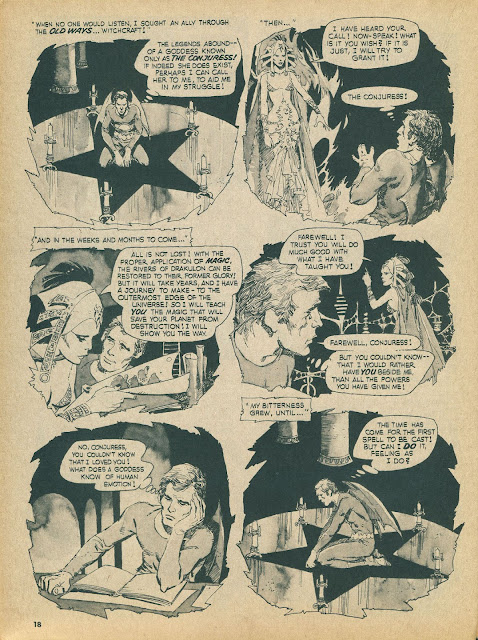During Archie Goodwin's run of Vampirella stories, which concluded with "And Be a Bride of Chaos", the writer revised the origin of Vampirella from what Forrest Ackerman had written. Turnabout being fair play, T. Casey Brennan, who took over as regular scripter of the Vampirella stories in issue #17, then revised what Goodwin had written about Dracula in issue #16. The result was, among other things, a stronger evocation of the Superman-myth than either Ackerman or Goodwin had managed.
"Lives" picks up directly from the conclusion of "Chaos," where the master vampire was buried when the chaos-gods he had worshiped brought his castle tumbling down. However, in the midst of the bloodsucker ranting about his plans to seek vengeance upon Vampirella, an apparition appears before him.
Contrary to what the editorial notes claim, the Conjuress did not appear in VAMPIRELLA #16. Possibly Brennan recycled her from some other script which I've not read, but what happens in the Goodwin script is that Dracula, a native of Vampirella's homeworld, commits a mortal sin by preying on his fellows, rather than drinking the blood supplied by the planet. The Drakulonians sentence the transgressor to disintegration, but the device actually propels Dracula into the realm of the chaos-god. That's the only entity the vampire encounters in the Goodwin tale, but Brennan counts on 1972 readers not to obsess about those details, and finds a totally different path to associate Dracula with the domain of chaos.
Meanwhile, Vampirella has been having some melodrama with her boyfriend Adam and Adam's father Conrad Van Helsing. Then the elder vamp-slayer gets a psychic hotline, informing him that Drac is back. Those psychic senses also tell Conrad that the master vampire is not on Earth, so the resourceful slayer uses Merlin's Mirror to send the hot-blooded heroine after him.
In the other dimension, Conjuress tells Dracula that he can only renounce the evil in his heart by lying on the "altar of repentance" and reflecting on his sins. Then she leaves, and Vampirella shows up, expecting a fight. What she gets is a revised origin for Dracula--which in essence, recasting the Count as Jor-El from the Superman mythos, the lonely voice trying to convince his people that their planet is doomed.
Dracula seeks to save his world with ancient witchcraft, summoning the Conjuress. She obligingly reveals a ritual that can be used to renew the planet's rivers of nourishing blood. However, the Conjuress leaves Dracula alone to complete the ritual, and his altruism has become tainted by his lust for the beauteous goddess. Because of Dracula's wayward spirit, the God of Chaos tempts him to abandon the path of goodness. Not only does this faux Jor-El not save his world, he preys on his fellows, and that's what gets him executed. Chaos then sends Drac to Earth to gather more sacrifices, which is how he crosses paths with Vampirella. Having heard the reboot origin, Vampi tries to put an end to Dracula's evil.
However, she can't bring herself to do it, not least because she herself has committed similar sins. Back in the real world, Conrad decides to smash the mirror-portal to protect his son from the bloodsucking beauty. However, the Conjuress shows up to reveal to Vampirella that she could not have killed Drac had she tried, for the experience in the other dimension was a test of Vampi's ability to conquer her "animalistic instincts," as much as giving Drac the chance to repent. So the mystic maiden sends the heroine back home.
However, moments later, Dracula comes to and becomes incensed at having been vulnerable to his enemy. He ignores the Conjuress' blandishments about reformation and re-dedicates himself to being "the personification of evil."
The parallelism of Drac and Vampi here is somewhat undercut by the next three Vampirella stories, in which the Conjuress talks Dracula into getting back on the path of atonement. These are all decent stories, but they lack the symbolic density that makes "Dracula Still Lives" a memorable mythcomic, combining the metaphysical tropes of world-salvation and self-abnegation with the psychological tropes of forbidden love and the deep attractions of transgression.










No comments:
Post a Comment